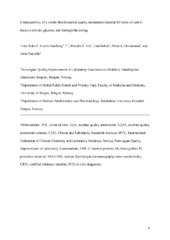| dc.contributor.author | Bukve, Tone | en_US |
| dc.contributor.author | Sandberg, Sverre | en_US |
| dc.contributor.author | Vie, Wenche S. | en_US |
| dc.contributor.author | Sølvik, Una Ørvim | en_US |
| dc.contributor.author | Christensen, Nina Gade | en_US |
| dc.contributor.author | Stavelin, Anne | en_US |
| dc.date.accessioned | 2020-06-23T11:37:34Z | |
| dc.date.available | 2020-06-23T11:37:34Z | |
| dc.date.issued | 2019 | |
| dc.Published | Bukve T, Sandberg S, Vie WS, Sølvik UØ, Christensen NG, Stavelin A. Commutability of a whole-blood external quality assessment material for point-of-care C-reactive protein, glucose, and hemoglobin testing. Clinical Chemistry. 2019;65(6):791-797 | eng |
| dc.identifier.issn | 0009-9147 | |
| dc.identifier.issn | 1530-8561 | |
| dc.identifier.uri | https://hdl.handle.net/1956/22830 | |
| dc.description.abstract | BACKGROUND: The optimal situation in external quality assessment (EQA) is to use commutable materials. No previous study has examined the commutability of a whole-blood material for point-of-care (POC) testing. The aim of this study was to determine the commutability of the Norwegian Quality Improvement of Laboratory Examinations (Noklus) organization's “in-house” whole-blood EQA material for C-reactive protein (CRP), glucose, and hemoglobin for frequently used POC instruments in Norway and to determine the possibility of using a common target value for each analyte. METHODS: The study was performed according to the Clinical and Laboratory Standards Institute guidelines. The EQA material was pooled stabilized EDTA venous whole-blood containing different concentrations of the analytes. The EQA material and native routine patient samples were analyzed using 17 POC and 3 hospital instruments. The commutability was assessed using Deming regression analysis with 95% prediction intervals for each instrument comparison. RESULTS: The EQA material was commutable for all CRP and hemoglobin POC instruments, whereas for glucose the material was commutable for all POC instruments at the lowest concentration analyzed [126.0 mg/dL (7.0 mmol/L)] and for 3 POC instruments at all of the concentrations analyzed. CONCLUSIONS: Noklus EQA participants using CRP and hemoglobin POC instruments now receive results that are compared with a reference target value, whereas the results for participants using glucose POC instruments are still compared with method-specific target values. Systematic deviations from a reference target value for the commutable glucose POC instruments can be calculated, and this additional information can now be offered to these participants and to the manufacturers. | en_US |
| dc.language.iso | eng | eng |
| dc.publisher | Oxford University Press | eng |
| dc.title | Commutability of a whole-blood external quality assessment material for point-of-care C-reactive protein, glucose, and hemoglobin testing | en_US |
| dc.type | Peer reviewed | |
| dc.type | Journal article | |
| dc.date.updated | 2020-01-15T12:02:31Z | |
| dc.description.version | acceptedVersion | en_US |
| dc.rights.holder | Copyright 2019 The American Association for Clinical Chemistry | |
| dc.identifier.doi | https://doi.org/10.1373/clinchem.2018.300202 | |
| dc.identifier.cristin | 1714786 | |
| dc.source.journal | Clinical Chemistry | |
